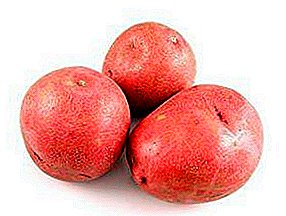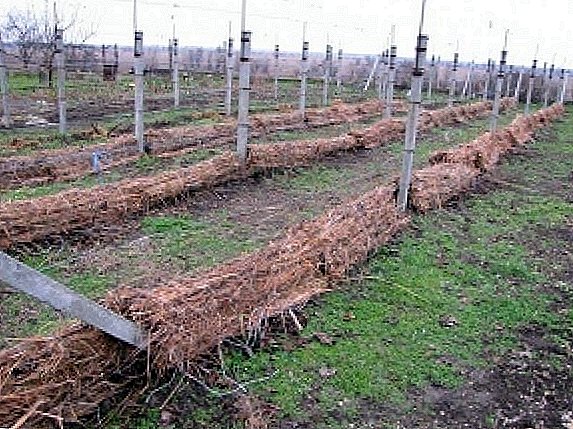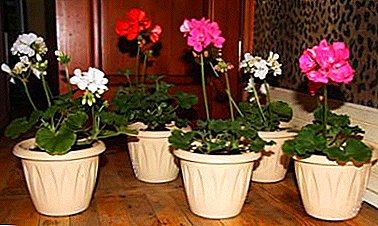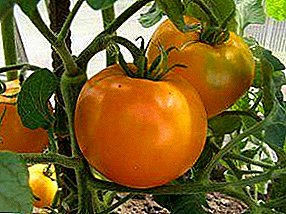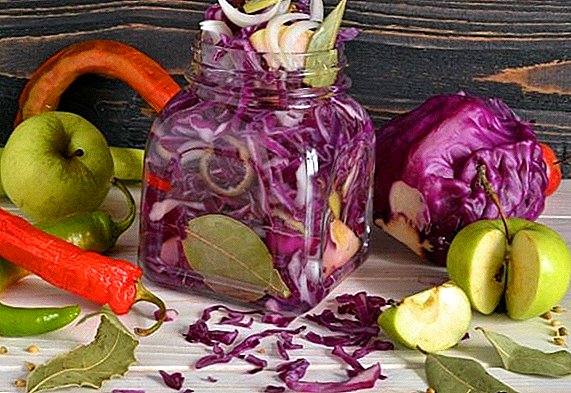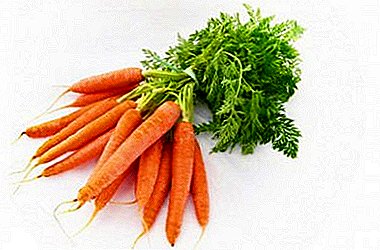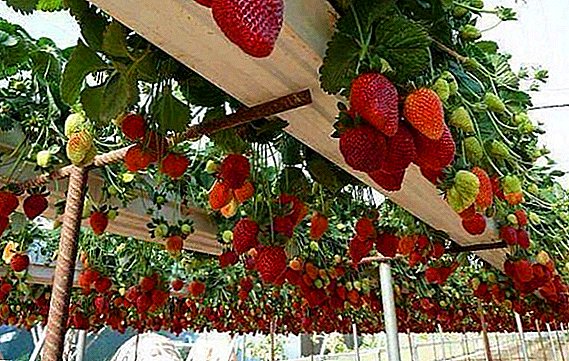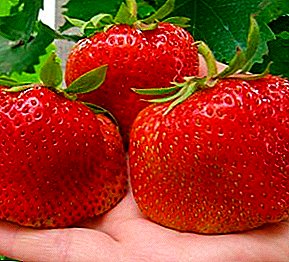 In recent decades, strawberries have become one of the traditional desserts on our table, regardless of the season and season, therefore many people today resort to growing this berry. The most progressive in our time is considered the Dutch technology of cultivation of the fruit, as it allows you to get high-quality yields almost all year round. Today we decided to elaborate on the basics of growing strawberries using Dutch technology.
In recent decades, strawberries have become one of the traditional desserts on our table, regardless of the season and season, therefore many people today resort to growing this berry. The most progressive in our time is considered the Dutch technology of cultivation of the fruit, as it allows you to get high-quality yields almost all year round. Today we decided to elaborate on the basics of growing strawberries using Dutch technology.
Technology features
The essence of the Dutch technology for growing strawberries is to create the best possible conditions for fruit bearing throughout the year with minimal effort and resources.
This is achieved by selecting high-yielding varieties and creating an optimal climate regime for them. For this, plants are grown in artificial greenhouses with an automated irrigation and fertilizer system. 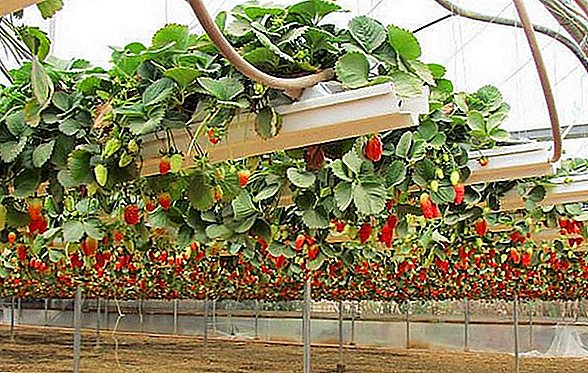
Did you know? Strawberry is the only berry on the planet, the seeds of which are located not inside, but outside the fruit.
Dutch cultivation technology makes it possible to organize the uninterrupted fruiting of strawberries in just a short period of time.
Learn about the features of growing strawberry varieties such as Roxana, Cardinal, Tristan, Kama, Alba, Mara de Bois, Honey, Cleary, Eliana, Maxim , "Queen", "Chamora Turusi", "Zenga Zengana", "Kimberly", "Malvina", "Festival".The main advantages of the Dutch technology over the traditional methods of growing berries:
- the ability to cultivate plants in any containers: garden pots, cups, bags, pallets, etc .;
- obtaining maximum yield with minimum area;
- the ability to use both horizontal and vertical type of planting seedlings;
- no need to grow berries in specialized areas: you can get the fruit on the windowsill, balcony and even in the garage;
- ensuring stable and high yield for every 1.5-2 months, which makes it possible to use this technology for commercial purposes;
- the quality and taste characteristics of berries grown in this way are not inferior to fruits produced by traditional methods;
- convenience and simplicity - after the process has been fully established, the technology requires only minimal effort to maintain it.
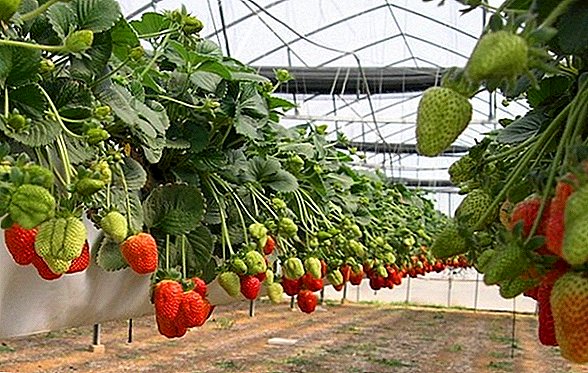
Planting varieties
The choice of the optimal variety of berries for the continuous production of high yields in artificial conditions is quite a difficult task.
If you decide to cultivate strawberries according to the Dutch technology, be determined that the variety of berries from the next flower bed will most likely not suit you, since the process involves fruiting in limited soil conditions.
Therefore, your choice, first of all, needs to be stopped on remontant strawberry varieties, which are capable of producing rich yields in any soil and climatic conditions.
The remontant varieties of strawberries include such as "Albion", "Elizabeth 2", "Fresco".
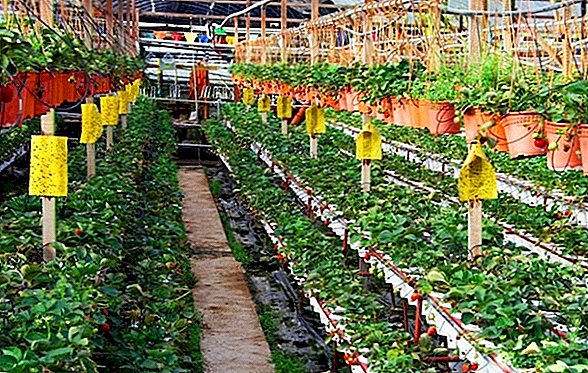
Did you know? In 1983, the largest strawberry was picked. Farmers from Roxton (USA) managed to grow a fruit weighing 231 g, by the way, the record has not been broken to this day.In addition, we should not forget that the strawberry belongs to the flowering plants, for fruiting which requires timely pollination of the flower. In artificial conditions, it is almost impossible to achieve cross-pollination, so the variety must necessarily have the ability to self-pollination.
Otherwise, your strawberries will not please anything except elegant and fragrant flowers.
Learn about the features of growing strawberries using Finnish technology.Considering all of the above, the following varieties will be the ideal choice for the Dutch technology of growing berries:
- "Darlelekt": Strawberry of early ripening, bred in France in 1998. Variety refers to the plants of short daylight hours, having one of the shortest periods between flowering and fruit ripening. Bushes are large, leaves of saturated green color. The berries are also large, the weight of one fruit is in the range of 20-30 g, but under optimal conditions it can increase up to 50 g. With intensive farming, about 1 kg of fruit can be harvested from 1 bush. The shape of the berries is heart-shaped, their color is bright brick, the surface is glossy. Winter hardiness varieties - medium.
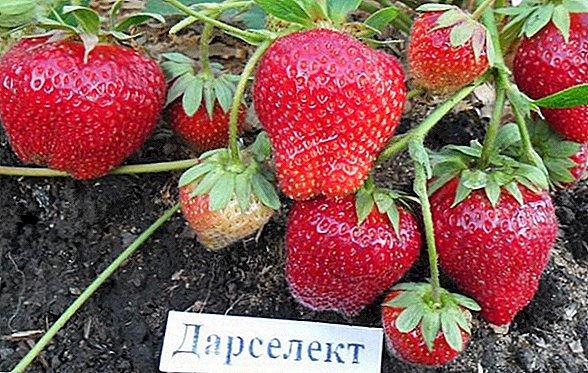
- "Maria": a variety of super early ripening with universal purpose. The plants are medium strong, with strong foliage, leaves of saturated green color. The berry is large, painted in dark shades of red, its surface is glossy. The weight of one fruit is within 30 g, the yield from one bush does not exceed 1 kg. The plant belongs to species resistant to diseases such as leaf spot, gray rot, wilt and fusarium. Winter hardiness of a grade high, flowers with firmness maintain short frosts.
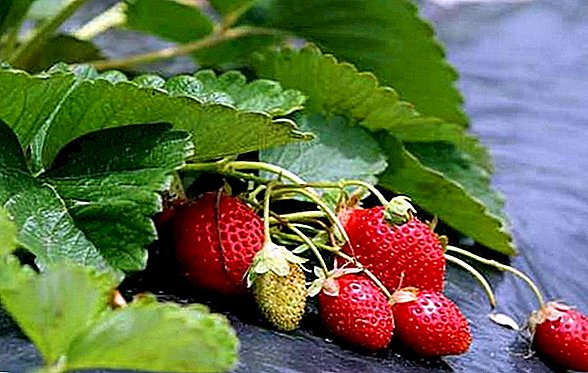
- "Marmalade": The plant is a product of Italian breeding, bred in 1989 thanks to the interbreeding of varieties such as Gorella and Holiday. The variety has an average ripening time and requires a short daylight hours. When harvested early, there is a second wave of fruiting. Plants sredneroslye, leaves slightly raised. Blade often dark green shades. Chlorosis resistant. The fruits of Marmelade are large, the weight of a single berry averages about 30 g. The shape of the berries is comb-like or barrel-shaped, the color of saturated red shades, the surface of the fruit is glossy. The yield from one bush is 800-900 g.

- "Polka": property of the Dutch school of breeding. The plant was bred in 1977 thanks to the interbreeding of varieties such as "Unduka" and "Sivetta". Variety refers to species with an average period of ripening. The bushes are quite tall, profusely leafy. Blade of bright green shades. "Polka" forms large conical fruits of rich red color, the weight of one berry is in the range of 40-50 g. Despite the fact that this strawberry does not belong to remontant species, it bears fruit for a long time. Winter hardiness varieties - medium.
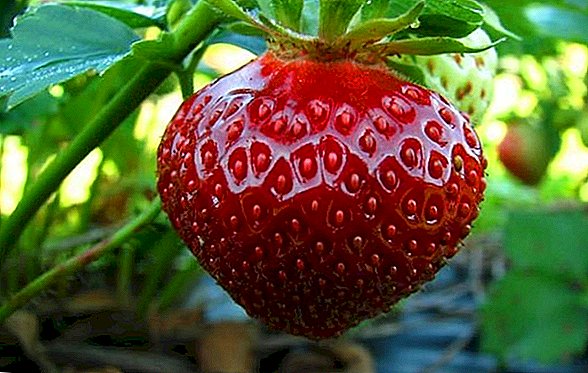
- "Selva": The plant was bred by American breeders in 1983 due to the interbreeding of varieties such as Ryton, Tufts and Pajero. The species belongs to the plants of a neutral daylight, therefore “Selva” bears fruit throughout the frost-free period of the year. The plant is vigorous, with large spreading leaves of saturated green shades. The fruits are large, dark red, shiny, their shape is often round-conical. The average weight of a berry is 40-60 g, so up to 1.5 kg of fruits can be collected from one bush. Winter hardiness "Selva" high.

- "Sonata": The plant was bred in the Netherlands in 1998 by crossing the varieties Polka and Elsanta. The variety is early, medium. The plants are tall, with great growth power. The leaves are not large, erect, bright green. The fruits are large, bright red in color, with a shiny surface. The average weight of a berry is about 40 g. Productivity is high, at least 1.5 kg of fruit can be harvested from one bush. Winter hardiness - high. "Sonata" is suitable for growing in a temperate continental climate.
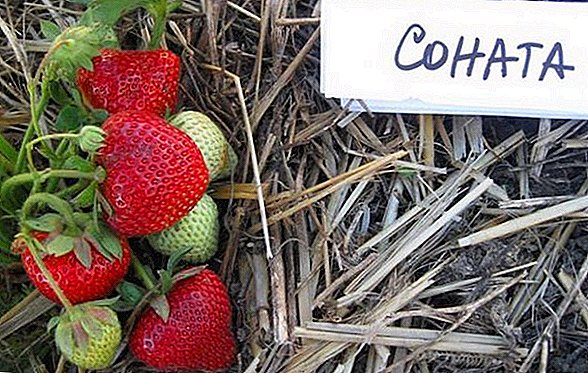
- "Tristar": remontant large-fruited variety, bred by crossing strawberry and strawberry "Milanese". The plant is compact, powerful, sometimes slightly elevated, with medium or strong foliage. Blade predominantly bright green shades. The fruits are large, conical shape, rich dark red shades, with a shiny surface. The weight of one berry is about 25-30 g. The variety is winter-hardy, drought-resistant, and also resistant to diseases and pests.
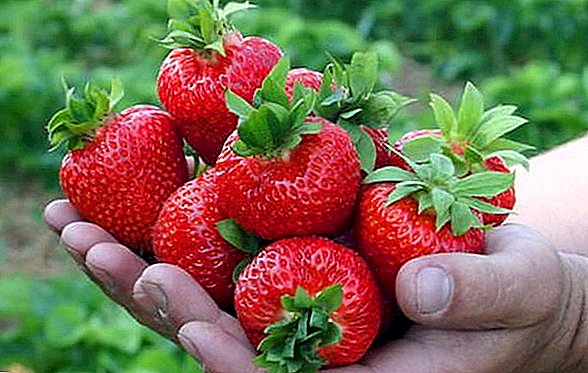
Did you know? To determine the quality of strawberries, just look at its color. The brighter and richer the shade of the berry, the more all sorts of nutrients and vitamins it contains.
Landing methods
Today there are only two systems for the effective cultivation of strawberry crops in artificial conditions. These are the so-called vertical and horizontal methods.
Each of them has its advantages and disadvantages, but often they both provide an opportunity to grow a full-fledged and rich harvest. Therefore, before you lean towards one of them, you must carefully determine the benefits of each.
Learn about the rules of planting strawberries in spring and autumn, how to plant strawberries under covering materials, how to plant strawberries in a garden bed, how to plant strawberries in a greenhouse.
Horizontal
The horizontal method of planting provides for the location of the plants especially parallel to the base of the room for growing. This means that the capacity or group of containers are always parallel to each other. 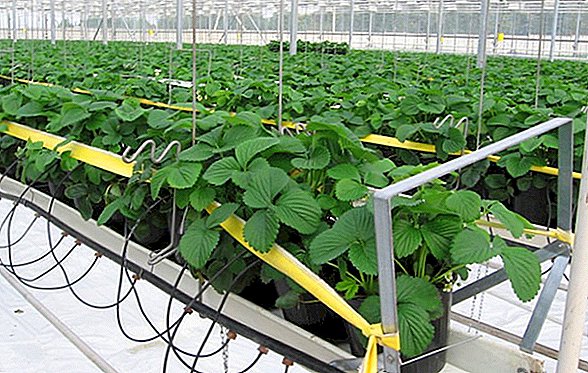 In this way, you can create several fruiting cascades of strawberry bushes. Often, owners of large greenhouses or farms resort to horizontal planting.
In this way, you can create several fruiting cascades of strawberry bushes. Often, owners of large greenhouses or farms resort to horizontal planting.
This arrangement of the territory creates the most favorable conditions for the quality and quick care of mass plantings and the arrangement of high-tech systems to ensure their livelihoods.
Vertical
In the case of a vertical planting, containers with fruit bearing plants are fixed in a direction perpendicular to the base of the room for growing strawberries. Thus, it is possible to create a structure in which the cascades of fruit-bearing plants tower one above the other without shading each other.
In most cases, this method of planting strawberries is resorted to by owners of small greenhouses or enthusiastic gardeners who want to grow an aromatic fruit right in their apartment, since almost everyone has the opportunity to hang pot on a balcony in a pot. 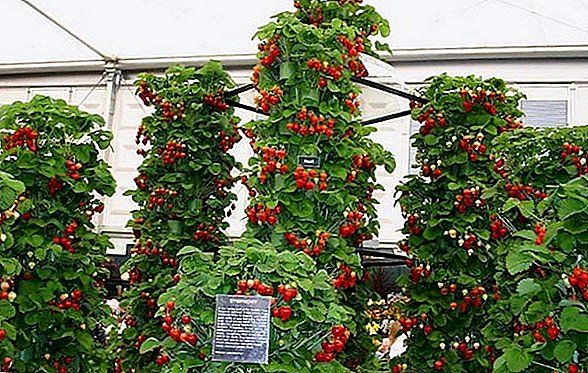 Despite its prevalence, vertical landing has a number of inconveniences, since it requires more complex technical solutions when drawing moisture and nutrients to each individual cascade.
Despite its prevalence, vertical landing has a number of inconveniences, since it requires more complex technical solutions when drawing moisture and nutrients to each individual cascade.
Did you know? Strawberry is one of the oldest fruits used by man for food. Its wild varieties were used during the Neolithic era.
Growing process
So, after you have decided on the variety of the future berry and the method of its cultivation, you can proceed directly to the process itself. However, many gardeners at this stage there are many difficulties.
Learn how to deal with diseases and pests of strawberries, especially with brown spot, verticillium wilt, nematodes, weevil.Despite its simplicity, the process has many subtleties, the non-observance of which can be the main reason for the lack of harvest. Therefore, we will consider in detail all the stages of the Dutch technology of growing strawberries.
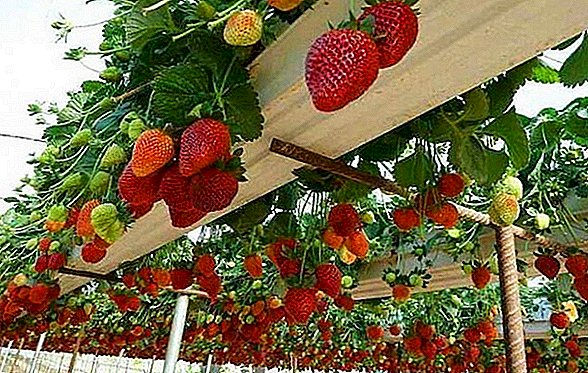
The process consists of the following steps:
- Preparing the soil for growing seedlings: as a substrate use any specialized soil, pre-enriched with nutrients. To do this, it is necessary to make potassium chloride, superphosphate and lime as recommended by the manufacturer on the package. It is possible to enrich the soil with organic fertilizers; for this, a small amount of manure is additionally added to it.
- Preparation of tanks for germination of seedlings: containers must be thoroughly cleaned from old substrate or other contaminants, and also disinfected with 4% formalin solution. Next, the prepared soil is stuffed in garden utensils. At the bottom of the hole should be made with a diameter of about 7 mm, and then equip the drainage system. For this, the bottom of the tank is covered with gravel or pebbles (15-20% of the total volume of the vessel).
- Sprouting seedlings: According to the general agrotechnology of growing seedlings from seeds or by grafting, two separate populations of mother plants are grown. This makes it possible to obtain continuous fruiting and avoid planting degeneration.
- Planting queen cells: seedlings are planted in previously prepared containers with soil (according to the method described above, as for the planting material). To start the process, it is best to choose spring time, since during this period the most optimal climatic conditions are observed. You can create the necessary microclimate and artificially, while the temperature should be within + 8-12 ° C, and humidity - about 85%.
- Plant care: It is carried out according to the general agrotechnical cultivation of berries. In addition, the Dutch technology provides for individual drip irrigation, fertilizing and creating a special microclimate for strawberries, so for this purpose it is necessary to establish a special system for maintaining plant life or take care of individual care for each shrub.
- Replacement seedlings: after collecting the berries, the plants are removed, and young seedlings are planted in their place. The withdrawn plants are cut off from old leaves and placed for wintering in conditions of low temperatures (from 0 to +2 ° С). The number of cycles of fruiting of one seedling should not exceed two, after which the plants completely change to young ones.
Priming
To obtain mother plants, you can use any special substrates or soil for seedlings from the nearest flower shop. It is important to avoid highly fertile soils from natural conditions, as they contain a huge variety of pathogens of various dangerous diseases. 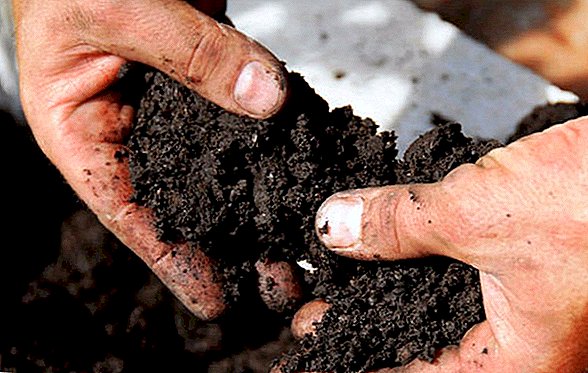 When growing fruit plants need to stock up on any sterile soil, purified from all kinds of weeds and vectors of dangerous diseases. You can buy it in almost all specialized stores.
When growing fruit plants need to stock up on any sterile soil, purified from all kinds of weeds and vectors of dangerous diseases. You can buy it in almost all specialized stores.
The main requirements for such a ground is a high moisture capacity, porosity and lack of toxicity. But the most suitable as such a substrate are peat, perlite, coke fiber and mineral wool.
You can prepare the soil yourself, for this you need to mix sandy soil, rotted manure and sand in the ratio of 3: 1: 1.
Important! If you decide to create the substrate yourself, it should be sterilized. To do this, all the components must be roasted in an oven at a temperature of + 120-125 ° С for 45 minutes.
Harvesting and growing seedlings
There are several ways to obtain high-quality strawberry planting material, but the most effective are two methods for obtaining seedlings. 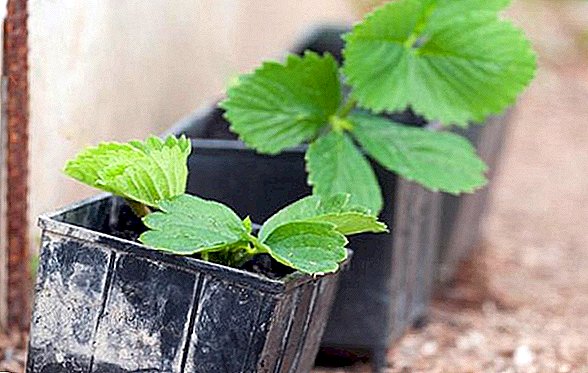
Consider them in more detail:
- Planting material can be obtained by growing uterine plants on a special plantation in open ground. After the onset of seasonal cold spells, the rooted mustache of one-year-old plants is carefully dug out, the foliage is removed and placed in a dark, dry place with a temperature of 0 to +2 ° C. The day before planting, seedlings are kept for 24 hours at room temperature, and unsuitable plants are discarded and disposed of. In this way, it is possible to create high-quality and abundantly fruiting planting material, but the main drawback of the method is the need to maintain mother-nurseries, which need to be updated at least once every 2 years.
- A simpler way to grow seedlings is the cassette method., as a result of which the pre-rooted young whiskers, periodically aged under conditions of low temperature from 0 to +2 ° C, become planting material. 1.5 months before the planned date of disembarkation, the whiskers are removed and grown in prepared garden containers. As a substrate, you can use any soil for plants from the nearest store. The first 4 weeks seedlings are grown in the shade, then in the fifth week it is exposed to the light, and transplanted to a permanent place from the sixth.
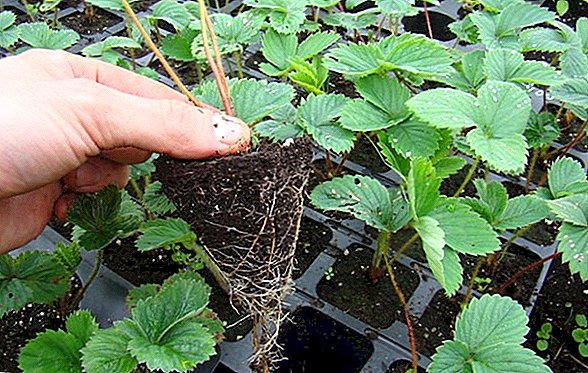 Strawberry Cassette Seedlings
Strawberry Cassette SeedlingsImportant! To obtain high-quality planting material on one-year-old plants, it is necessary to remove flower stalks, otherwise you will get weak planting material with an underdeveloped root system.
Lighting
Proper lighting is one of the main conditions for obtaining rich harvests, so care should be taken to install additional lighting when growing remontant strawberry varieties.
As such a light source, you can use both special garden lamps and room fluorescent lamps. The light source must be set up at a distance of at least one meter from the plants.
In order to improve the efficiency of the lamps, you can use reflective elements. Lamp consumption is: 1 pc. for every 3 square meters. m greenhouses.  Duration of daylight should be about 12 hours. For this, the plants are illuminated daily in the morning from 8 to 11 hours and in the evening from 17 to 20 hours. В пасмурную погоду длительность подсвечивания можно увеличивать.
Duration of daylight should be about 12 hours. For this, the plants are illuminated daily in the morning from 8 to 11 hours and in the evening from 17 to 20 hours. В пасмурную погоду длительность подсвечивания можно увеличивать.
В таком случае искусственное освещение может использоваться на протяжении всего дня.
Система полива и подкормки
The irrigation system should provide drip irrigation of seedlings, while the methods of moisture and nutrients entering the soil are not important. The main thing: to avoid direct contact with water on the leaves or fruits of strawberries.
Find out how often you need to water strawberries.The volume and frequency of irrigation are provided according to the general agrotechnology of berry cultivation. With the proper functioning of the system, it will be possible to get not only high yields, but also to protect the plants from the development of various pests and infectious diseases.
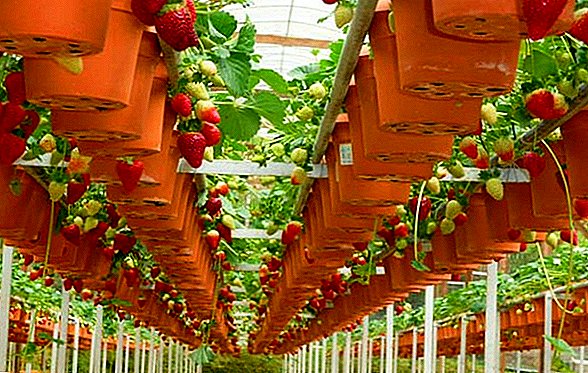 Top dressing is also made in liquid form, therefore its quantity must be necessarily corrected in relation to the total volume of introduced moisture.
Top dressing is also made in liquid form, therefore its quantity must be necessarily corrected in relation to the total volume of introduced moisture.The nutrient solution is prepared from the following components:
- potassium chloride - 10 g;
- ammonium nitrate - 80 g;
- tap water - 10 l.
Fertilizers are applied directly to the substrate and root zone, the fluid flow rate is about 100 ml per bush.
The procedure is carried out 2 times during the growing season: 1-2 weeks after transplanting and during the active ejection of the peduncles, also to increase the yield of the plant, it can be additionally fertilized at the stage of active growth of berries. Foliar fertilization of strawberries with the Dutch cultivation technology is not provided. 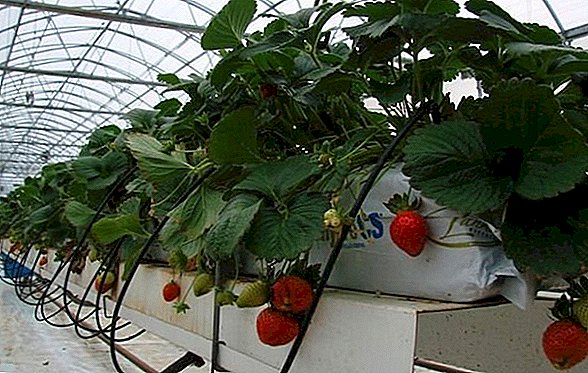
Microclimate
In order to provide the most favorable conditions for the fruiting of strawberries throughout the year, the plants need to create a special microclimate.
It will be useful for you to learn how to make tincture on vodka from strawberries, how to make compote, how to make jam, marshmallow, jam, how to freeze.
The optimal temperature for intensive growth and ripening of the fruit is within + 18-25 ° C, however, plants can develop safely in a temperature range from +12 to +35 ° C.
At the stage of mass appearance of peduncles, the air temperature should be reduced, since this helps to intensify the process. Therefore, it is best that during this period it does not exceed +21 ° C.
Important! Temperatures below +12 ° C can cause inefficient and prolonged flowering, with an increase in the rate above +35 ° C, there is difficulty in pollination and the setting of berries.

It should also maintain the optimum humidity, which should be in the range of 70-80%. If the air is excessively dry, then it must be humidified by spraying, excessively high humidity is eliminated by periodic ventilation.
In addition, experienced plant growers, if possible, recommend to monitor the concentration of carbon dioxide in the greenhouse. This indicator should be about 0.1% of the total mass of atmospheric air.
Capacity for seedlings
As pots for growing strawberries use a lot of garden containers. These can be special flowerpots for flowers, boxes, containers, and even professional plastic pipe systems filled with a nutrient substrate. In this case, the choice is yours.
The most economical and simple option are special plastic bags, tightly packed with soil. Such containers can be used in both horizontal and vertical growing methods. 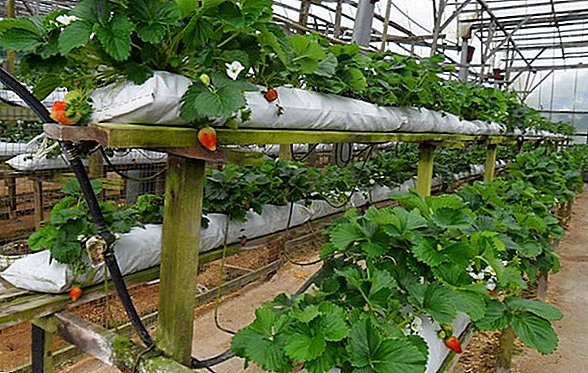 Growing seedlings in plastic bags However, in this case, thickened plantations should be avoided, as this will adversely affect the overall process of strawberry development and its fruiting. Plants in packages are planted in a staggered manner, with bushes about 15 cm in diameter, at a distance of at least 25 cm from each other.
Growing seedlings in plastic bags However, in this case, thickened plantations should be avoided, as this will adversely affect the overall process of strawberry development and its fruiting. Plants in packages are planted in a staggered manner, with bushes about 15 cm in diameter, at a distance of at least 25 cm from each other.
Care
After careful observance of all the above recommendations on the cultivation of strawberries, the care of plantings is only to maintain the necessary climatic conditions, as well as periodic feeding.
Since initially sterile soil is used for planting, additional weeding and processing of the plant do not require. However, preventive examinations of plantings 1 time per week must be carried out necessarily.
Important! The process from planting to picking berries should be carried out in cycles, with a length of 2 months each, otherwise it will not be possible to achieve continuous fruiting throughout the year.
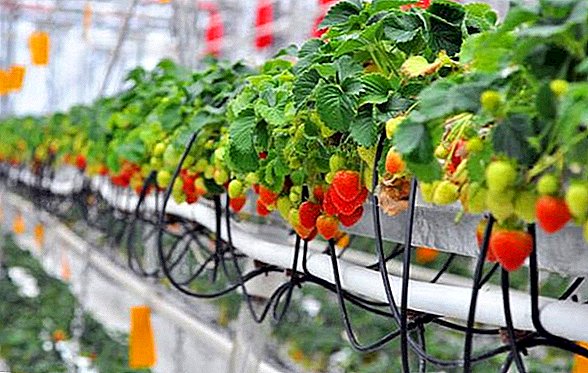 Today, the Dutch technology of growing strawberries is one of the most technologically advanced and efficient ways to cultivate berries. This method makes it possible to obtain rich yields, regardless of the climatic characteristics of the region, as well as the place of cultivation.
Today, the Dutch technology of growing strawberries is one of the most technologically advanced and efficient ways to cultivate berries. This method makes it possible to obtain rich yields, regardless of the climatic characteristics of the region, as well as the place of cultivation.Therefore, fragrant berries throughout the year can be obtained both in a high-tech greenhouse and on its own window sill.



